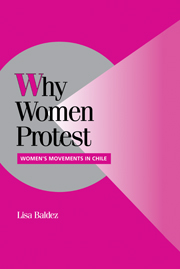Book contents
- Frontmatter
- Contents
- List of Figures and Tables
- Preface
- 1 WHY WOMEN PROTEST: TIPPING, TIMING, AND FRAMING
- 2 MOTHERS OF THE COLD WAR, DAUGHTERS OF THE REVOLUTION: A HISTORICAL OVERVIEW OF WOMEN AND CHILEAN POLITICS
- Part One Women Against Allende
- Part Two Women Against Pinochet
- 6 GENDERED NETWORKS AND THE REBIRTH OF CIVIL SOCIETY
- 7 WOMEN DEFEND LIFE: MASS PROTESTS AND THE WOMEN'S MOVEMENT
- 8 DEMOCRACY IN THE COUNTRY AND IN THE HOME: WOMEN FOR AND AGAINST DEMOCRATIC TRANSITION
- 9 WHY WOMEN PROTEST: COMPARATIVE EVIDENCE
- References
- Index
8 - DEMOCRACY IN THE COUNTRY AND IN THE HOME: WOMEN FOR AND AGAINST DEMOCRATIC TRANSITION
Published online by Cambridge University Press: 06 July 2010
- Frontmatter
- Contents
- List of Figures and Tables
- Preface
- 1 WHY WOMEN PROTEST: TIPPING, TIMING, AND FRAMING
- 2 MOTHERS OF THE COLD WAR, DAUGHTERS OF THE REVOLUTION: A HISTORICAL OVERVIEW OF WOMEN AND CHILEAN POLITICS
- Part One Women Against Allende
- Part Two Women Against Pinochet
- 6 GENDERED NETWORKS AND THE REBIRTH OF CIVIL SOCIETY
- 7 WOMEN DEFEND LIFE: MASS PROTESTS AND THE WOMEN'S MOVEMENT
- 8 DEMOCRACY IN THE COUNTRY AND IN THE HOME: WOMEN FOR AND AGAINST DEMOCRATIC TRANSITION
- 9 WHY WOMEN PROTEST: COMPARATIVE EVIDENCE
- References
- Index
Summary
In the late 1980s, the opposition moved away from popular mobilization and gradually accepted the electoral timetable established by the Constitution of 1980. Women's organizations leveraged their ability to mobilize supporters into demands for policy change on the agenda of the opposition. They achieved a level of political clout unprecedented for Chilean women. Both the opposition and the military government embraced the demands of the women's movement in the context of strenuous competition to secure women's votes in the plebiscite of 1988 and the elections of 1989.
Yet within the women's movement, tremors began to surface along the fault lines established during the days of national protest in the mid-1980s. These fissures widened after the formal transition to civilian rule in 1990. Since then, the women's movement has demobilized and women's policy agenda has been only partially implemented (Cáceres 1993; Centro de Estudios de la Mujer 1993; Provoste 1995; Molina and Provoste 1997). Many of the organizations that formed in the context of dictatorship continue to exist today, but they lack the influence they had prior to the transition. Until the election of Socialist Ricardo Lagos to the presidency in 1999, women found themselves largely excluded from positions of political authority. Ironically, while the suppression of “politics as usual” during the military regime allowed new groups to gain prominence, the return of democracy has pushed these groups back out of the political arena (Waylen 1993; Jaquette 1994; Frohmann and Valdés 1995; Matear 1996; Schild 1998; Valenzuela 1998). It has proven difficult to sustain the women's movement as an autonomous political force.
- Type
- Chapter
- Information
- Why Women ProtestWomen's Movements in Chile, pp. 168 - 195Publisher: Cambridge University PressPrint publication year: 2002

